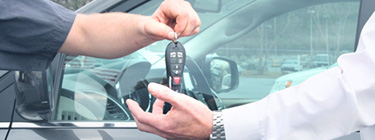Converting a Minivan for Wheelchair Access
As you get in your newly modified AMS Vans wheelchair accessible minivan and ride off into a brighter future, you might wonder how your standard minivan becomes the highly prized vehicle it is for people with disabilities. The road to a high quality, low cost wheelchair van begins there, with the minivan, which most handicap van conversion companies believe is the best option for wheelchair access modification for a number of reasons, including a roomy interior and automatic, sliding side doors.
Though there are numerous modification styles (raised roof, lowered floor, rear entry, side entry, ramp, lift, etc.), this article focuses on the popular side-entry handicap van conversion. When your minivan arrives at the AMS Vans facility for conversion, the first thing that happens is...
Your vehicle is carefully inspected for dents and scratches, cracked windows, and all electrical systems are checked to make sure we return your new handicap van in the same condition we received it (other than what is affected during conversion). You'll be sent a copy of the inspection sheet and asked to sign off on it before we begin the modification process.
In the first actual production step, your van is covered with a special sealant to protect the paint.
Next, everything in the interior of the van is removed except the dashboard. All seating, carpets and rear interior panels are taken out to make room for the handicap accessible interior.
Now, the wiring harnesses from the center of the vehicle are relocated to run along the sides of the van, after which the fuel tank and rear axle are removed in preparation for the lowered floor.
With the van prepped, a specially designed floor pan, dipped in a rust-proofing solvent, is welded securely into the vehicle, creating a 10" lowered floor--sufficient floor space and headroom to comfortably accommodate a wheelchair user and a higher rear suspension.
With the lowered floor in place, the fuel tank and rear axle are reinstalled, along with a new exhaust system.
From there, your van goes to the Paint department for installation and painting of the ground-effects panels. These are placed on the exterior of the vehicle to conceal the body changes created by the lowered floor, and painted to match your minivan's color.
Next, the minivan heads to the Finishing department. A protective undercoating is applied, and automotive-grade carpet, interior panels, anti-skid flooring, and seating are installed according to the configuration best suited for your specific, predetermined requirements.
Last in the production process, but definitely not least, the anti-skid, powered, side entry ramp is installed at the passenger-side sliding door, and power is connected. (The production process for rear-entry ramps is nearly the same, though standard, rear-entry ramps are manually operated.)
It's time for the final conversion inspection! All conversion components and everything related to the conversion are tested and cleaned. All tools and unnecessary materials are removed, so the vehicle can proceed to the...
Post-conversion, 134-point inspection, when we make sure all systems work seamlessly together.
In the last step, the minivan is detailed from bumper to bumper. Your newly converted handicap minivan is ready to be picked up or delivered to your driveway!
There you have it! The meticulous, innovative handicap accessibility conversion from AMS Vans takes an average of 3-4 weeks from the moment we receive your vehicle to the phone call you receive to let you know your wheelchair accessible van is ready for the road!


